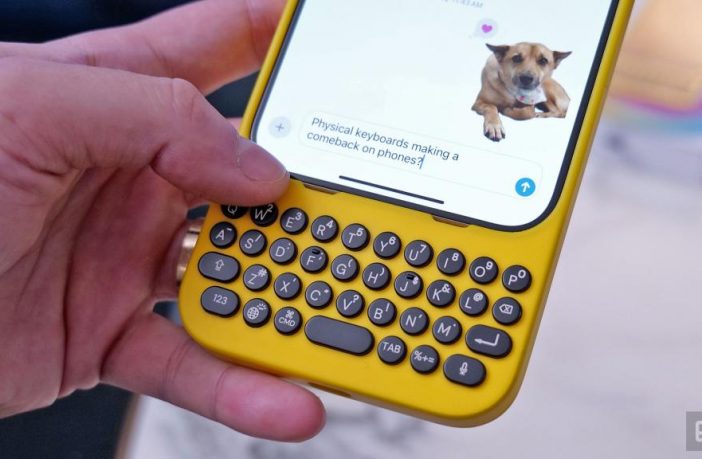
The original iPhone convinced me (and many others) that touchscreen typing was the future. The last thing I expected to test at CES 2024 here in Las Vegas was a mobile accessory that attempts to bring back the physical keyboard. And, while I wanted to think of Clicks as something for people who can’t let go of the past, what I found was a gadget that solves some modern problems by drawing inspiration from the past.
The design of the clicks couldn’t be simpler. It’s a silicone case (the Clicks website actually says it’s Liquid Silicon, but I think that’s a typo) with a physical keyboard bolted to the bottom. There’s a small vegan leather accent on the back, small bumps to accommodate buttons and switches, and a passthrough connector on the bottom (either Lightning or USB-C depending on your device). At launch, Clicks will be available for three devices starting at $139: the iPhone 14 Pro, iPhone 15 Pro, and iPhone 15 Pro Max.
The first problem Clicks tries to solve is giving you space back on your screen, because when you don’t need to display a virtual keyboard at the bottom all the time, things suddenly feel a lot more spacious. And Clicks achieves this brilliantly. But personally, with the increasing size of phones (especially the new foldables), this has never really been an issue for me. But that doesn’t mean it’s not an issue for others, so it’s nice to see Clicks offering people alternatives to glass typing.
Another major goal of Clicks is to optimize your device by providing tons of shortcuts, which to me is much more appealing. This almost gives your phone the kind of speed and productivity you get on a laptop. You can press CMD+H to go home, press Spacebar to scroll through Safari, press CMD+Space to open Spotlight search, and much more. Some commands even work in third-party apps like Instagram, which is really handy. And after seeing Apple add a single action key to the iPhone 15 Pro, my head is already spinning with the possibilities of having more than 30 customizable shortcuts.
Finally, there’s the simple joy of having physical keys to complain about. Although you don’t have mechanical switches like on a desktop keyboard (Clicks feature rubber domes), the tiny nickel-plated keys feel solid and provide a nice tactile bump with each press. You also get a handy backlight so you don’t have to suffer in dark rooms. The only problem is that after years of typing on screens, I’m not really sure I want to go back. And that probably goes double for anyone who prefers swipe input methods.
After years of tapping on glass, just writing a short text using Clicks felt sluggish. And even with their circular design that leaves enough space between the keys, I found myself fumbling. But then the old habits started to creep back and I can easily see how those longing for their old Blackberries, Sidekicks or Motorola Envy might be enchanted.
Now that I’ve used it, I can’t deny that there’s something endearing about Clicks. But when it comes to getting more use out of a device, I lean more toward foldable phones or just larger screens. Additionally, there are a few other minor issues, like iPhones not being able to handle charging and data simultaneously over USB-C, which could be an issue for anyone relying on wired CarPlay when using Clicks . Plus, sticking a keyboard on the bottom of an iPhone, which already has an extra-long 19.5:9 aspect ratio, might make you feel like you’re lugging around a stack of rulers. And if you own an Android phone, you’re just out of luck (at least for now). But there’s no doubt that Clicks are a charming device, especially these flashy yellow and blue/pink models.
Clicks will be available starting February 1 for the iPhone 14 Pro with other models following later this spring.
We’re reporting live from CES 2024 in Las Vegas from January 6-12. Follow all the news from the show here.
Gn tech




